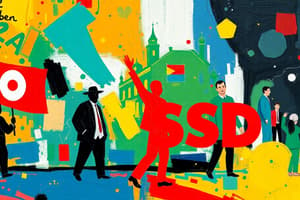Podcast
Questions and Answers
What tempo is the first movement?
What tempo is the first movement?
Allegro
Who composed it?
Who composed it?
J.S. Bach
What is J.S. Bach's full name?
What is J.S. Bach's full name?
John Sebastian Bach
What era did he compose in and what years?
What era did he compose in and what years?
Where was he born and where did he die?
Where was he born and where did he die?
What instruments did he write for?
What instruments did he write for?
What is ritornello form?
What is ritornello form?
What is a concerto?
What is a concerto?
What is a concerto grosso?
What is a concerto grosso?
What is a continuo?
What is a continuo?
What is figured bass?
What is figured bass?
What instruments are in the first movement?
What instruments are in the first movement?
What is the key signature?
What is the key signature?
What is the tonality?
What is the tonality?
What is the time signature?
What is the time signature?
What is the metre?
What is the metre?
What is the texture?
What is the texture?
What are the features?
What are the features?
What is triadic movement?
What is triadic movement?
What is step movement?
What is step movement?
What is an episode?
What is an episode?
What is a canon?
What is a canon?
What is concerto grosso in this piece?
What is concerto grosso in this piece?
What is ripieno/tutti?
What is ripieno/tutti?
What is a cadenza?
What is a cadenza?
What is the tempo of the 2nd movement?
What is the tempo of the 2nd movement?
What is the instrumentation of the 2nd movement?
What is the instrumentation of the 2nd movement?
What is the key signature of the 2nd movement?
What is the key signature of the 2nd movement?
What is the tonality of the 2nd movement?
What is the tonality of the 2nd movement?
What is the time signature of the 2nd movement?
What is the time signature of the 2nd movement?
What is the metre of the 2nd movement?
What is the metre of the 2nd movement?
What is the texture of the 2nd movement?
What is the texture of the 2nd movement?
What are the features of the 2nd movement?
What are the features of the 2nd movement?
What is polyphonic texture?
What is polyphonic texture?
What is canon as a musical term?
What is canon as a musical term?
What is ternary form?
What is ternary form?
What does affectuoso mean?
What does affectuoso mean?
What are thirds in music?
What are thirds in music?
What are the similarities between the two pieces?
What are the similarities between the two pieces?
Study Notes
Brandenburg Concerto No. 5 Overview
- Composed by J.S. Bach, known formally as John Sebastian Bach.
- A prominent work from the Baroque era (1685-1750).
- Notable for its lively first movement in Allegro tempo.
Composition Details
- Birthplace: Eisenburg, Germany; Death: Leipzig, Germany.
- Written for harpsichord and string instruments.
- The first movement features solo flute, solo violin, harpsichord, and strings.
Musical Structure
- Employs ritornello form, characterized by a recurring theme.
- Concerto definition: A piece for soloist and orchestra.
- Concerto grosso is for multiple soloists and orchestra, present in this work with the solo flute and violin.
Key Musical Concepts
- Continuo: A prominent accompaniment style in the Baroque using harpsichord and cello.
- Figured bass technique directs the harpsichordist on playing.
- The key signature of the first movement is D major, indicated by F and C sharp.
Characteristics of the Movements
- Time signature of the first movement: Cut common time (2/2).
- The overall tonality in the first movement is major; features include homophonic and polyphonic textures.
- Texture varies between independent melodies and harmonic support in different sections.
Compositional Techniques
- Key features include:
- Ritornello: Recurring theme throughout the piece.
- Episodes: Unique sections interspersed between ritornelli, primarily featuring solo instruments.
- Canon: Imitative technique employed by flute and violin.
- Ripieno/Tutti occurs when all instruments play together.
Cadenza and Movement Variations
- Cadenza: A soloist's showcase of technical prowess; in this piece, the harpsichord features a lengthy 64-bar passage.
- The second movement (Affectuoso/Lento) shifts to a more expressive tempo with instrumentation focusing on the solo flute, violin, and harpsichord, set in B minor.
Second Movement Features
- The second movement is characterized by a polyphonic texture with two or more melodies.
- Ternary form (ABA) used in this movement, showcasing variations and development of themes.
- The term "affectuoso" denotes an affectionate or expressive style.
Common Elements
- Similarities between movements include:
- Use of ritornello and episodes, harpsichord accompaniment.
- Techniques like canon, trills, ornamentation, and figured bass.
- Presence of polyphonic textures across both movements.
Studying That Suits You
Use AI to generate personalized quizzes and flashcards to suit your learning preferences.
Description
Test your knowledge on J.S. Bach's Brandenburg Concerto No. 5 in D major with these flashcards. Learn about the composition, including tempo, composer details, and historical context in the Baroque era. Perfect for music history enthusiasts and students alike.




